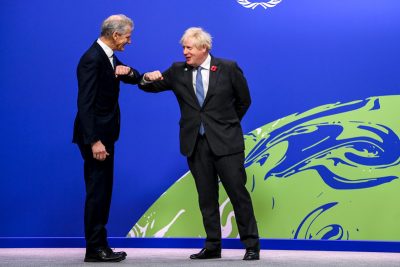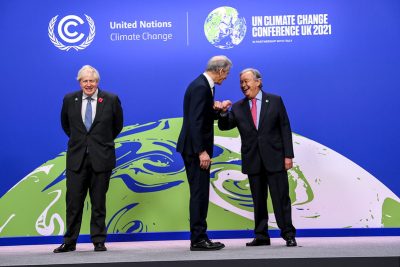NEWS ANALYSIS: Norway’s new Labour prime minister headed for the 26th UN Climate Change Conference in Glasgow that opened on Monday, armed with more Norwegian petrokroner and promises that his oil-producing nation will meet its climate goals. Jonas Gahr Støre and others in the Norwegian delegation know, however, that their credibility is at stake and risks being soiled by their own North Sea crude oil and gas.

Debate has raged within Norway for years over the country’s conflicting roles in the climate crisis. Norwegian governments have continued to actively promote offshore oil exploration and production, while also portraying the country as both climate- and environmentally conscious. Norwegian governments have also long defended their oil with creativity and sought to pay their way out of the paradox, with former Prime Minister Jens Stoltenberg sending billions to Indonesia and Brazil to save rain forests, for example, or funding emission cuts in other countries while allowing Norway’s own oil industry to keep producing and profiting in high gear. The rain forest initiative, meanwhile, has had mixed results at best.
Just before leaving for Glasgow, Støre announced that he’s nonetheless doing much the same, opting to provide more climate-related funding instead of reining in the oil and offshore industries. His government has no more intention of halting oil and gas exploration or limiting production than any of his predecessors have. Stoltenberg, also from the Labour Party, didn’t interfere when state-owned oil company (now Equinor) launched into highly disputed tar sands projects in Canada and fracking in the US, both of which resulted in large losses in addition to all their emissions. Nor was Stoltenberg able to push through a much-hyped carbon capture and storage project at the former Statoil’s huge Mongstad refinery. His so-called “moon-landing” crash-landed instead.
Støre’s immediate predecessor, former Prime Minister Erna Solberg of the Conservatives, also maintained active oil production and exploration, despite loud protests from environmental lobby and a major if unsuccesful lawsuit filed by grandparents and climate organizations. Nor did Solberg’s government step in to halt a highly controversial drilling project Equinor wanted to conduct in the Australian Bight. It was eventually dropped, but not because of Norwegian government intervention.
Støre, meanwhile, is just as eager to “develop, not phase out” Norway’s oil industry. He argues that the industry’s ongoing revenues, profits, competence and technology are what’s needed to fund and carry out the transition to “greener” energy from ventures within battery production, hydrogen and offshore wind, for example, and maybe even succeed at carbon capture and storage “because we have these good milieux.” Production of Norwegian oil and gas will decline, he claims, when other greener industries come up.
Instead of curtailing exploration and production now, Støre is offering to double Norway’s annual share of earlier financial contributions to help poor countries respond to climate change damage and cut their own emissions. That sort of climate financing extends back to the less-than-successful UN Climate Conference in Copenhagen in 2009. That’s when wealthy countries that generate the vast majority of the world’s carbon emissions couldn’t agree on carbon cuts of their own, but promised to contribute the equivalent of USD 100 million by 2020 to poor countries suffering the most from climate change. The promise was reaffirmed at the UN climate summit in Paris in 2015 but the goal hasn’t been met.

Now more money and a new financing plan is needed, to which Støre is committing Norway to annually contribute up to NOK 14 billion (around USD 1.1 billion) by 2026, double the NOK 7 billion it donated in 2020. Norway’s enormous oil revenues over the years have made the country wealthy, with most of the money due to come out of the Norwegian government’s large foreign aid budget and the rest from a new climate fund that also receives private contributions.
There were some immediate complaints and concerns at home that the money still wouldn’t come fast enough to where it’s needed most. Dagfinn Høybråten, secretary general of the humanitarian organization Kirkens Nødhjelp (Norwegian Church Aid) quickly sought assurances that this would be new, extra money and not come at the expense of other areas of Norway’s foreign aid budget. “Otherwise, people in poor countries can feel a bit cheated and won’t be so enthusiastic about this declaration,” he told Norwegian Broadcasting (NRK).
Høybråten was otherwise positive to the plan. “From an historic perspective, Norway has a responsibility for high carbon emissions, and an economic ability to contribute,” Høybråten said. “It’s therefore only right and reasonable that Norway takes it share of responsibility for this job (the climate funding).”
It’s expected to be one of the hardest nuts to crack during the two-week UN climate summit, so Norway’s contribution will likely be welcome. Støre hopes the money will be used to speed the transition away from coal as a source of energy and towards development of more renewable energy.
‘Must take responsibility now’
Others, both inside and outside Norway, still want the Norwegian government to do more to cut its own emissions. The EU itself has joined calls to halt more oil exploration in the Arctic and, eventually, trim production, even declaring it won’t buy oil from Arctic areas. Norway’s new minister in charge of climate and the environment, Espen Barth Eide, has indicated that Norway won’t be granting new drilling licenses in the most sensitive northerly areas of the Arctic, but points out that much of Norway’s ice-free seas and even its mainland areas lie above the Arctic Circle. Eide, also from Norway’s Labour Party and, like Støre, a former foreign minister, also points out that Europe needs Norway’s gas, especially right now as an energy crisis rages, and fuels Norway’s economy at the same time.
“We of course must take responsibility now,” Eide said during a national radio debate before heading for Glasgow. He insisted Norway was “coming with very high ambitions” along with lots of money to the Glasgow summit. “The most important thing is to fund new energy sources,” he said, pointing especially to offshore wind power. Like many others, Eide claims the transition “can’t happen overnight,” even though it can be argued that the Labour government from 2005 to 2013, in which he served, didn’t do much to curb production of fossil fuels or develop new energy sources, and the Conservative government that followed until Labour won again this fall didn’t either.

Now, with a sense of urgency rising at what’s being called both the “thriller in Glasgow” and “our last chance” to save the climate, many of Norway’s new but same players will be active again. Eide will, along with his counterpart from Singapore, lead negotiations for new regulations for the thorny international market for climate quotas. “We’re part of the EU’s quota market, which functions,” Eide has noted, but older quota systems from the Kyoto summit “are more uncertain” and unreliable. The UN summit hinges, after all, on creating confidence in international climate rules and regulations that will work and be followed.
Norway’s challenge in Glasgow and elsewhere is its ongoing position (adhered to by prime ministers from Stoltenberg to Solberg to Støre and several before them) that Norway’s oil is part of the solution and not the problem. Like Solberg, Støre contends that halting Norway’s industry will also end its so-called “green shift.” They firmly believe that Norwegian oil, produced with relatively low emissions compared to many other countries and in a transparent and democratic country, is simply better than a lot of the oil produced in other less-open and democratic countries.
There will be pressure on Norway, not least from the EU’s new ban on oil and gas from the Arctic. Neither Eide nor Norway’s new Oil & Energy Minister Marte Mjøs Persen (who’s notably not traveling to the summit in Glasgow) seem overly concerned by the EU ban, believing it will mostly be a matter of defining the Arctic itself and what constitutes it. They don’t believe it will include oil and gas from oil fields off much of Northern Norway.
Støre himself is prepared for critical questions in Glasgow, and told NRK during the weekend that “we will answer them well.” He stressed that Norway “puts strict demands on our oil fields to bring carbon emissions down by 50 percent by 2030. We will also have a very active business policy to bring forth the new sources of renewable energy and technology for them.
There was at least some good news when leaders of the world’s 20 largest economies agreed during the weekend to continue to limit global warming to 1.5 degrees. Some experts, including those at Norway’s own respected classification and analysis firm DNV, claim that means Europe must have zero emissions in 2042. That in turn will make it necessary to impose a worldwide carbon tax that should be at least the equivalent of USD 250 in Europe (Norway has agreed on that already). In addition come a need for bans on all power plants fueled by coal or oil by 2040, electrification of everything that can be electrified (even some of Norway’s oil fields are being electrified from the mainland) and use of hydrogen, synthetic or biofuel where electrification can’t occur.
Commentator Kjetil B Alstadheim in newspaper Aftenposten questioned the need for a two-week climate summit in Glasgow, claiming that the G20’s weekend in Rome should have been enough to solve the climate crisis. With China, the US, India and the rest of the G20 standing for 85 percent of the world’s emissions, Alstadheim thinks they should have been able to decide on a price for emissions, and to then cut their own emissions to cut the resulting bill.
In the global framework, Norway is a small player and its own emissions are miniscule compared to other countries’. It exports the oil that causes emissions elsewhere, though, and that what makes Norway jointly responsible for the crisis. And to be held accountable, too.
newsinenglish.no/Nina Berglund

